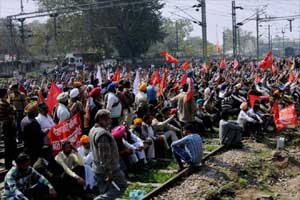The practice of professional politicians assuming leadership of trade unions could be curbed. Keen to unleash wide-ranging changes in federal labour laws, the Narendra Modi government is proposing to disallow “outsiders” to be trade union office bearers in organised-sector establishments. As for unorganised-sector units, where 94% of the Indian workforce is employed but trade union activity is relatively less robust, outsiders can continue to be office bearers subject to a cap of two persons per registered union.
A draft code on industrial relations prepared by the Union labour ministry also seeks to stipulate that workers cannot go on strike unless a notice is given to the employer six weeks in advance. Also, the bar on strikes during conciliation proceedings, which is now enforced only in the case of public utility services, would be extended to all industrial establishments, if the draft code is approved by Parliament.
The government, keen to create an employment climate conducive for industries to hire freely without having to fear about staff expansion leading to binding constraints, is also planning to extend the facility to lay off workers without government’s nod to all units employing fewer than 300 workers. This freedom is now available to factories employing up to 100 workers only. However, to protect workers’ interests, the severance package would be trebled from the current norm of 15 days’ pay.
In case of a dispute between one trade union and another, and if the government feels that the dispute is of “considerable importance”, it could make an application to the industrial tribunal for “seizing the dispute in adjudication”. The order of the tribunal in such cases would be final and no civil court would have the power to entertain any suit or other proceedings in relation to the dispute, if the draft becomes law.
The planned reforms are also aimed at checking militant trade unionism that could hit industrial activity.
As per the draft code, “No worker shall stage, encourage or instigate such forms of coercive actions as wilful, ‘go-slow’, squatting on the work premises after working hours or ‘gherao’ of any of the members of the managerial or other staff during conciliation proceedings and no worker shall stage demonstrations at the residence of the employers or the managerial staff members during conciliation proceedings and adjudication proceedings before the Tribunal and National Tribunal.” Also, every registered union would require to submit to the registrar an audited general statement of all receipts and expenditure annually.
Punitive measures including imprisonment has been suggested in the code that would amalgamate three labour laws: The Trade Unions Act, 1926, the Industrial Employment (Standing Orders) Act, 1946 and the Industrial Disputes Act, 1947. Mass casual leave by 50% of the workers, as per the draft code, would also be considered as a strike.
The Centre reckons that success of its Make in India campaign and plan to increase the share of manufacturing in GDP from the current 16% to 25% hinge on the rationalisation of labour rules. The plan to extend the freedom to lay off workers when needed to all establishments employing fewer than 300 would benefit thousands of units, analysts said. The growth of tens of thousands of units is stunted due to their inability to resort to retrenchment, layoffs, closure and transfers.
Labour Pains:
* No outsider can take leadership role in TUs in organised-sector units.
* Not more than two ousiders can be ffice bearers in TUs in unorgansied sector.
* No strike unless notice was given six weeks in advance.
* Freedom to retrench, lay off workers for units with staff of up to 300.
* Severance compensation to increase to 45 days’ pay
For Updates Check Economy News; follow us on Facebook and Twitter
